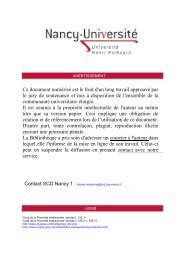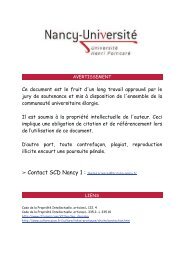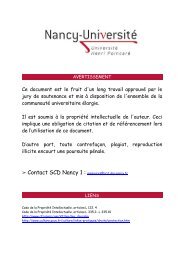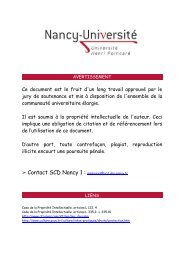Ce document numérisé est le fruit d'un long travail approuvé par le ...
Ce document numérisé est le fruit d'un long travail approuvé par le ...
Ce document numérisé est le fruit d'un long travail approuvé par le ...
You also want an ePaper? Increase the reach of your titles
YUMPU automatically turns print PDFs into web optimized ePapers that Google loves.
148<br />
neoplasia.<br />
STRUCTURAL ORGANIZATION OF<br />
PPARs<br />
The nuc1ear receptor subfamily of ppARs [1]<br />
consists of three isotypes named a (NR1C1,<br />
[2]), ~/o (NR1C2), and 'Y (NR1C3) (tab<strong>le</strong> 1).<br />
The different members .are encoded by<br />
se<strong>par</strong>ate genes. The humanand mouse PPARy<br />
gene transcription generates two transcripts,<br />
yI and 12 resulting from alternative promoter<br />
usage and differential splicing [3-5]. ppAR12<br />
has an additional 29 and 30 NH2-terminal<br />
amino acids sequence in human or mouse<br />
ppAR12 protein respectively. In humans, a<br />
third transcript ppARy3 is generated by<br />
differential promoter usage yielding a protein<br />
identical to PPARyl [5]. Like other nuc1ear<br />
receptors, ppARs have a similar protein<br />
structure consisting of a NH2-terminal NB<br />
domain, a DNA binding domain, a hinge<br />
region and a COOR-terminal ligand-binding<br />
domain. The DNA binding-domain share 85%<br />
similarity within the ppARs subfamily<br />
whereas the ligand-binding domains are only<br />
70% similar within the subfamily members.<br />
Two activating function domains (AF) have<br />
been identified AF-1 contains a<br />
phosphorylation site within a consensus target<br />
sequence for a mitogen-activated protein<br />
kinase (MAPK) within the NB domain of<br />
ppARa and y. AF-2 is located in the COOHterminal<br />
sequence of the ligand-binding<br />
domain ; its presence is necessary for binding<br />
of coactivators who increase the basal<br />
transcription ofPPAR-dependent genes.<br />
TISSUE EXPRESSION<br />
Tissue expression of ppARs is diverse (tab<strong>le</strong><br />
1) [6-9]. PPARa is mainly expressed in tissue<br />
having high fatty acid metabolism and ?igh<br />
peroxisome-dependent activities such as lIver,<br />
kidney, heart or in steroidogenic tissue such as<br />
adrenal gland. Higher expression of ppARy is<br />
r<strong>est</strong>ricted to adipose tissue, sp<strong>le</strong>en and<br />
Hervé Schohn et al.<br />
int<strong>est</strong>ine. Lower PPARy expression is<br />
observed in lung, breast and mammary glands.<br />
Whi<strong>le</strong> ppARy1 distribution correlates with<br />
that of PPARa, PPAR12 expression is<br />
r<strong>est</strong>ricted to adipose and colon. PPAR f3/o is<br />
expressed in almost aIl tissue and often at<br />
higher <strong>le</strong>vels than others PPAR isotypes,<br />
except in liver where the receptor expression<br />
is low [7]. The high<strong>est</strong> expression of<br />
PPAR~/8 is observed in the developing<br />
neural tube and in the epiderma during rat<br />
development [10].<br />
ACTIVATION OF PPARs<br />
Formation ofthe heterodimer<br />
PPARs bind to a specific hormone response<br />
e<strong>le</strong>ment, named peroxisome proliferator<br />
response e<strong>le</strong>ment (PPRE), in the promoter of<br />
target genes (figure 1). PPARs action is<br />
mediated through heterodimerization with the<br />
9-cis retinoic acid receptor (RXR) [11, 12].<br />
The PPAR/RXR consensus PPRE is a direct<br />
repeat of the AGGTCA sequence spaced by<br />
one base also referred to DR1 (see [13]). The<br />
precise sequence of PPRE and the spacer<br />
nuc<strong>le</strong>otide are important in the binding of<br />
nuc<strong>le</strong>ar receptors as hetero- or homodimers<br />
[14-16]. Other nuc<strong>le</strong>ar receptors including<br />
retinoic acid receptor (RAR), COUP-TF1 and<br />
hepatic nuc<strong>le</strong>ar factor-4 (HNF-4), bind to<br />
DR!. Nakshatri and Bhat-Nakshatri [16] have<br />
demonstrated that base position within the<br />
consensus sequence and the spacer nuc<strong>le</strong>otide<br />
determine the binding preference of<br />
PPAR!RXR and RARIRXR heterodimers and<br />
HNF4 homodimers on DR1. Moreover, the<br />
promotor context determines whether an<br />
e<strong>le</strong>ment function as a PPRE or an HNF-4<br />
response e<strong>le</strong>ment. Thus, the presence and<br />
relative <strong>le</strong>vel of promoter-specific<br />
transcription factors will determine the<br />
specificity of transcriptional response <strong>le</strong>vel.<br />
PPAR activation has also been shown to occur<br />
not only on the canonical DRI : PPARlRXR<br />
heterodimers binds in vitro to<br />
the palindromic <strong>est</strong>rogen response e<strong>le</strong>ment
















